Transforming Content Efficiency: Tridion and Precision Content Empower NCCI's Digital Journey

Recently, Tridion’s team convened with its partner Precision Content (PC) to discuss the joint value proposition of both companies. The event was organized by Elsa Sklavounou, RWS, VP AI Alliances, Global Partnerships.
From the PC team, Rob Hana (Chief Information Architect) walked us through PC’s solutions and NCCI project case study to demonstrate PC and Tridion’s joint value proposition in practice. Like Tridion, PC brings expertise in structured content but with a focus on end-to-end technical communication consulting.
It serves as a technical innovator and systems integrator through its bundled offering that includes professional services, training, and technology. Components of its solution include structured authoring methods, content lifecycle management, DITA/XML design and implementation, information architecture, content strategy, and structured content delivery.
Microcontent at the core of PC’s value proposition
Rob emphasized that microcontent is the key driver of AI, voice, and chat. PC defines microcontent as one primary idea or concept that is easily scannable. It is labeled for clear identification and meaning and appropriately written for use anywhere and anytime it is needed.
PC views microcontent as various parts or blocks of a topic. However, there are instances where topics can be reduced to a single block. Topics represent a unit of work, while blocks are a medium for interchange.
Topics are suitable for publishing to print and online as ‘pages’, while it is blocks that are suitable for publishing to chatbots and automated assistants (voice /AR/VR) as responses.
Topic and block structure:
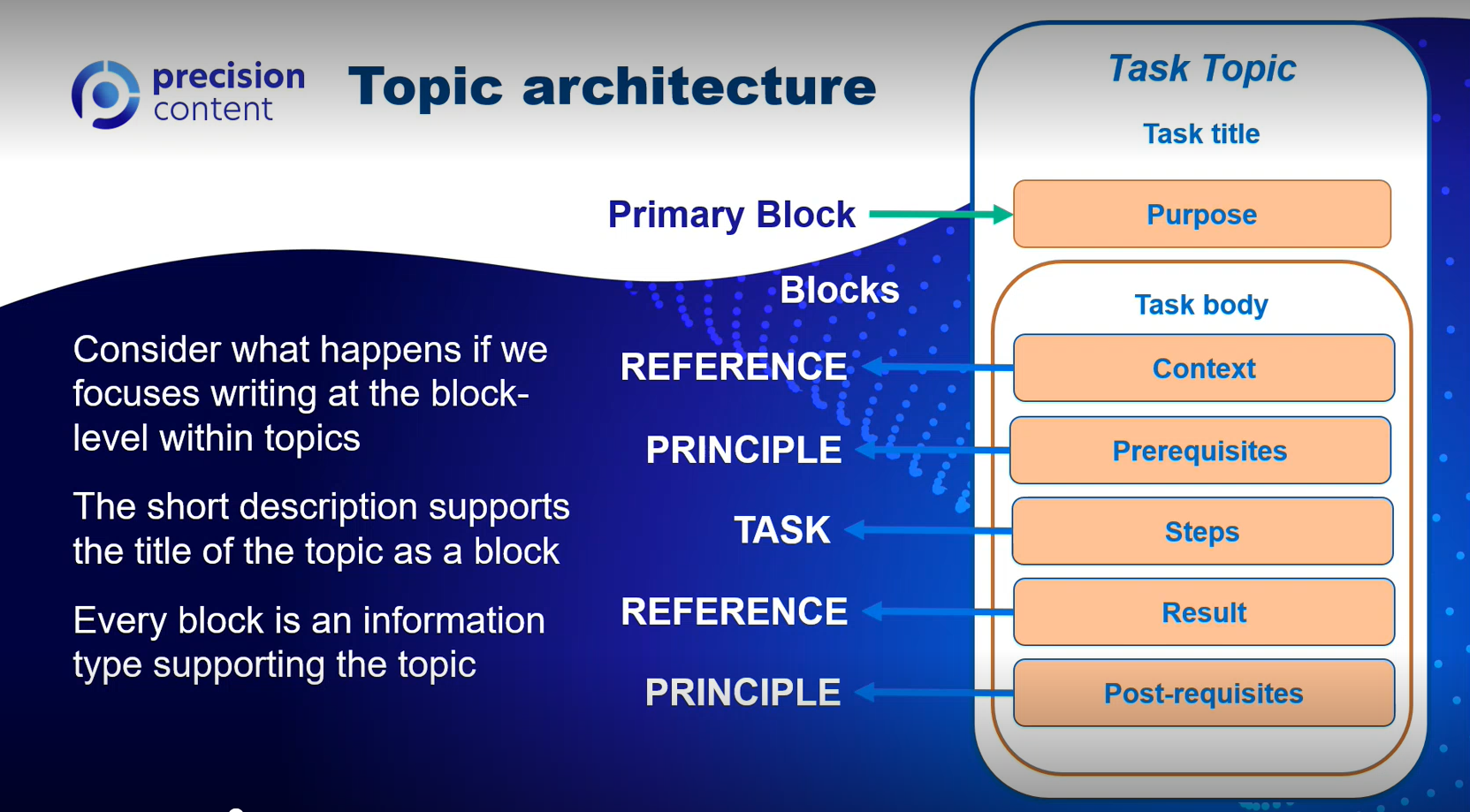
These blocks serve only the relevant information that the user wants. Users end up saving a significant amount of time in sourcing the exact information that they need. The units of microcontent contain the piece of standalone content and the metadata record that connects it to the larger idea or concept.
Rob shared the four principles of intelligent microcontent:
- Focus: Must be only about one subject as it allows content to operate as building blocks of information
- Function: Must be bucketed into a precision content information type (reference, task, concept, process, or principle), so that it can be matched to the user intent
- Structure: Must use predictable patterns and language
- Context: Must be easily relatable to other content and designed to fit a larger information ecosystem
Case in Point: NCCI Project – a joint PC and Tridion solution
NCCI stands for National Council on Compensation Insurance in the US and serves 37 state regulatory bodies. Rob mentioned that his team has been working on this project for the past 6 years. NCCI gathers data, analyses industry trends, and provides objective insurance rate and loss cost recommendations.
NCCI also serves private insurance carriers with extensive documentation and guidance on compensation insurance. E.g., NCCI’s content includes ‘The Basic Manual’ which has roughly 800 pages of information and tables used to administer workers’ compensation policies. NCCI also maintains a database of more than 4,000 job classifications that are used by companies to classify their operations. These are extensively cross-referenced across all their manuals.
NCCI handles a large volume of data, for instance in 2021, NCCI analyzed 3.3 million policies worth more than $26 million in premiums.
The project involves a complete digital transformation of NCCI’s content to make it much more efficient. Some of the areas that needed an overhaul and the respective solutions include:
Lacked appropriate structure
The original format that NCCI had included a national menu with state-specific rules. It was a quite complex system to navigate for the users because they had to browse through a lot of irrelevant information before they could reach the relevant information. PC worked with DITA to structure the content in a way that could serve different states.
As a first step, Tridion and PC worked to transition NCCI’s content from Doc Book to Documentum to Tridion Docs. This helped to substantially speed up the time to delivery. It involved complex use of release management, baselining, and workflow automation.
Struggled to keep content up to date
NCCI had irregular review and approval cycles for filed and non-filed content. There was no state-wise approval schedule. Some states often fell several filings behind other states. There was a significant time lag between content being prepared and ultimately being published.
Tridion brings rich features such as structured content with a central repository or single source of truth. This facilitates content reuse and accelerates the time to create content. Further, Tridion’s advanced content delivery features, ensure that the content is published consistently and quickly across all channels.
Road ahead
Rob mentioned that while significant progress has been made, there are many more improvements planned ahead including the need to facilitate more content reuse. E.g., transforming all manuals and guides targeted for the new delivery channels and developing a new web content delivery platform where Tridion Sites also comes into the picture.
The plan also includes adding new options for regulators to assist with filings, deploying a new content-as-a-service platform, and developing new conversational UIs.
Overview of the solution deployed with Tridion Docs at the helm
Tridion Docs, being compatible with several apps, was interconnected with the backend and front end and everything in between. In the process the entire content cycle from creation to distribution was streamlined, benefitting NCCI’s internal and external users with a lot of efficiency.
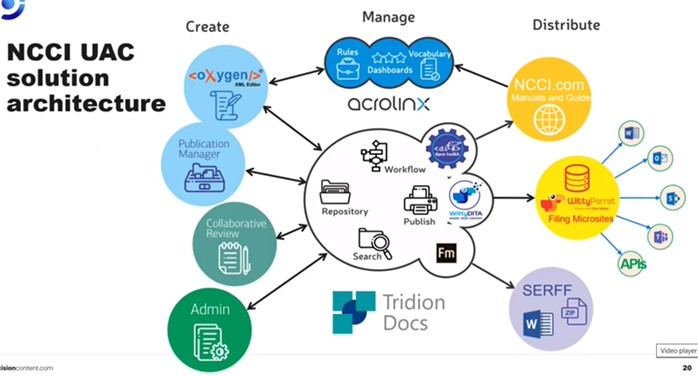
PC and Tridion worked with the NCCI team, who are experts in their domain (insurance) and have a decade of experience working with tools such as DocBook and XML. Hence, they well understood the idea of structured content. Yet several changes had to be introduced to make it easy for the authors to work with the solution. E.g., we introduced advanced architecture such as strongly-typed content structures, core/exception modeling, taxonomy integration, etc.
Topic Architecture: An exceptional approach
Topic architecture involves the microcontent network that Rob explained earlier. The most notable difference in the case of NCCI is that PC is implementing this architecture right from deployment to delivery. This is in contrast to the past where most clients had roped in PC towards the end to bring in the microcontent.
Creating blocks at NCCI has been more granular as PC didn’t want leads or blocks to be under a topic as it wanted a more granular microcontent. PC, therefore, broke down each block further with metadata and change-tracking.
Traditional (LHS) vs. NCCI (RHS) topic architecture
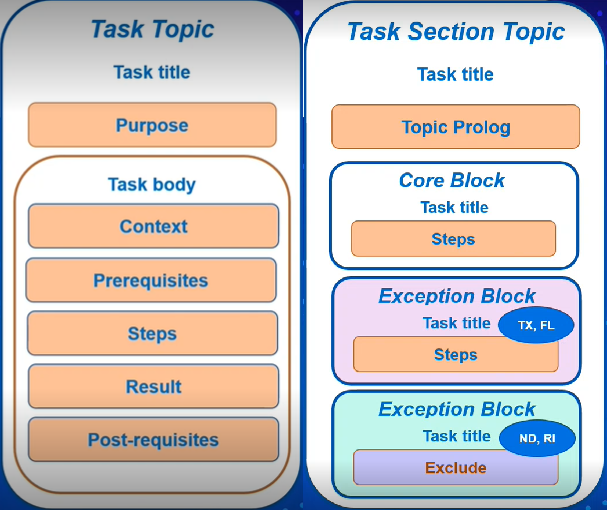
The challenge even at this granular level was to manage exceptions that varied across the 37 states. The traditional in-line conditional profiling won’t work, hence PC had to devise a new custom solution. This involved conditionalizing the entire blocks for individual states as core (that are common across all states) or exceptions. It simplified the conditional reuse that NCCI needed.
In practice, this means that if there are no exceptions for any particular state then the block directly gets published. Rob explained this with three different examples:
- Maine: Exception doesn’t apply, hence the core block gets published
- Florida: Exception applies, hence the exception block gets published
- Rhode Island: Since it is excluded for this given regulation, nothing is published
With these examples, Rob demonstrated how microcontent makes NCCI’s content easy to reuse and accurate.
Series of maps to introduce new metadata
PC introduced several maps to manage complex content lifecycles. This helps streamline the various changes that the content needs to undergo in a much more organized way.
Maps involved in the content lifecycle
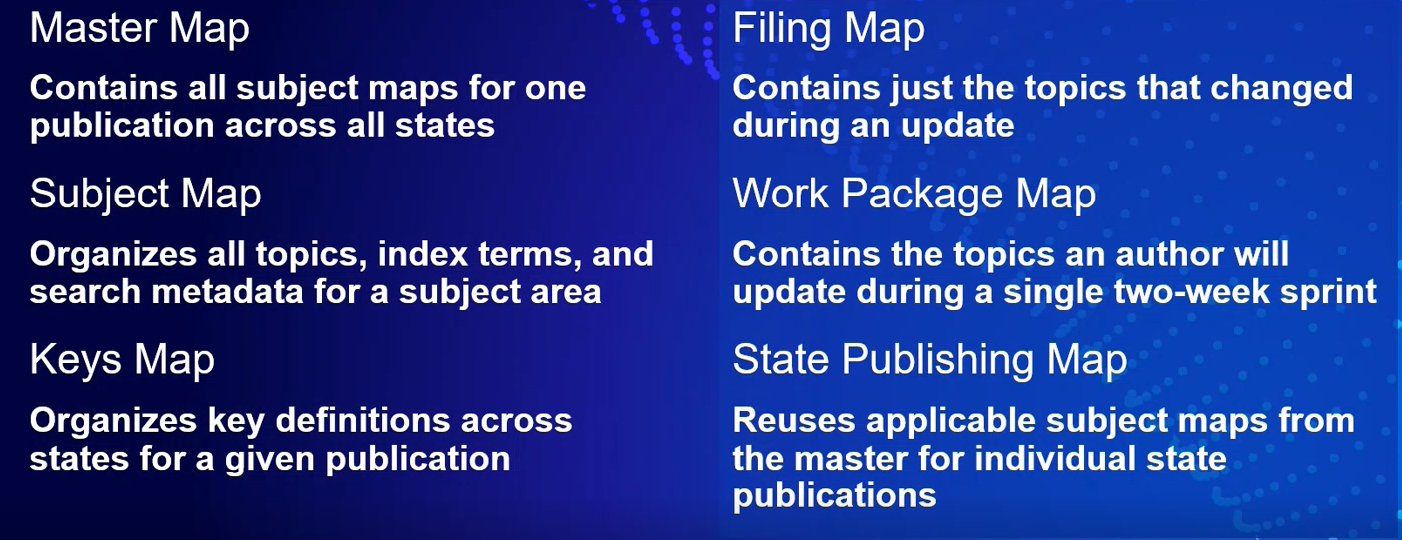
To explain the way in which these maps work together Rob shared an example that depicts the way in which any changes, whether it is fixed interval or ad-hoc work, until the updated content gets approved by the State authority and finally published:
Content lifecycle example
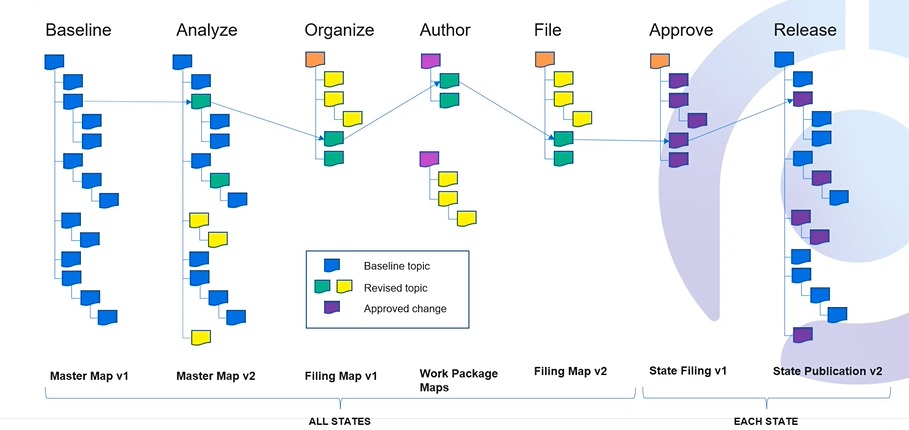
Tridion Docs the enabler
Rob explained that it is Tridion Docs with its baselining feature that allowed PC to implement this workflow and freeze specific versions of any object in a publication. Rob mentioned that many other tools don’t offer such capability. Tridion Docs baselining features and APIs are highlighted in this implementation. APIs were used to build in a lot of automation to help move a lot of complex content into this workflow.
Summarizing the solution
To round up the NCCI solution, Rob shared the delivery highlights which include:
- Dynamic web delivery - to create a content time-machine
- Class lookup tool - to lookup job classifications
- Regulator microsites – web-based reviewing sites for regulators
- Microcontent delivery – to share content across all departments
- Chatbots – to find answers quickly
- On-demand PDF publishing - combines states and dates
- RTF policy forms - industry insurance forms
- Detailed change tracking guides - captures material changes and reasons
- Content-as-a-service delivery – open APIs to access content
- Intelligent push-technology for circulars - triggering client notifications in workflow
If you would like to learn more about how Tridion can help your business, click here.

